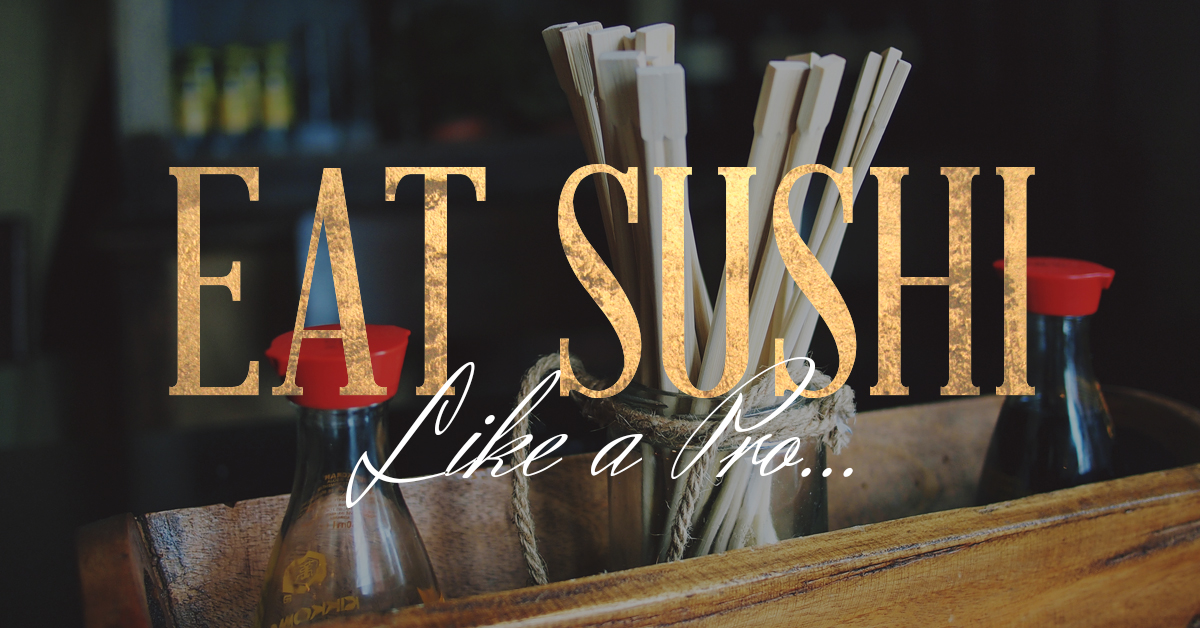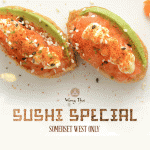
While eating Sushi is traditionally a Japanese custom, as a Thai restaurant we would like help you enjoy this well loved ancient Asian cuisine the way it was intended. Though you will probably never get reprimanded in a restaurant for mistreating your fish, knowing how to eat sushi the correct way enhances the experience and even turns the meal into a cultural lesson. Serious sushi chefs consider making these edible delicacies an art form that takes years to master. Eating sushi the proper way respects their efforts and shows just how cultured you really are.
What you need to know:
Almost every sushi restaurant, should have the following items on the menu sashimi, nigiri, maki, and temaki.
Sashimi refers to slices of raw fish prepared on a plate without rice. In general, this is the most basic and cleanest way to eat sushi, but may not be appropriate for the beginner.
Nigiri refers to slices of raw fish over an oval-shaped ball of rice. These are prepared to order by the sushi chef and are typically seasoned lightly with a tiny amount of wasabi and soy sauce before it comes to you.
Typically, maki includes one or two types of fish and vegetables rolled with rice in a sheet of roasted seaweed and cut into bite-sized portions. This is usually the best starting point for people who are squeamish about eating raw fish.
Temaki is quite similar to maki, except the ingredients are rolled into a cone shape that you hold and is often referred to as a hand roll.
Condiments: A plate of sushi includes wasabi, a spicy root plant with a punch stronger than raw ginger. This spicy condiment is sometimes included in maki and nigiri, but is available if you desire more. Pickled ginger comes in thin, pink slices on the side of the plate and is used for cleansing the palate between bites. You’ll also have a shallow dish to dip your sushi in soy sauce. There are usually two soy sauce options, a salty sodium rich one (with a red lid) and the lower sodium (green one) which is way healthier and better for cholesterol and high blood pressure issues.
Basic Do’s and Don’ts:
1. DO: Pick up sushi with your chopsticks (hashi) If you don’t know how to use chopsticks, you can learn! (see a helpful tutorial, here).
2. DON’T: Skewer your sushi with chopsticks or a fork, if you can’t use chopsticks it’s more polite to eat with your hands, according to Japanese culture.
3. DO: Place your chopsticks on a ceramic rest when you are not eating. This is considered good table manners, just like you would rest your knife inside your fork in Western culture.
4. DON’T: Never ever rub your chopsticks together to remove splinters, this is considered very rude, rather ask for new chopsticks or gently wipe with a napkin below the table surface!
5. DO: Use the back ends of your chopsticks when taking food from a shared plate. It is considered highly unhygienic and poor etiquette to use the front end of your chopsticks to pick up edibles from a shared platter. Just flip it around and use the grip ends instead.
6. DON’T: Point either end of your chopsticks at another person. Just don’t lift them to high above your plate in general. Especially in Asia!
7. DO: Dip the fish side of the sushi into soy sauce. This not only brings out more flavour in the fish but also keep the rolled rice together so your sushi keeps its shape.
8. DON’T: Dip the rice side. The rice is seasoned and flavored with the chef’s expertise. You dip it into the soy sauce, you diss the chef.
9. DO: Use wasabi sparingly, for similar reasons. Traditionally, you leave it up to the chef to add the right amount of wasabi to your sushi. But today it’s more a matter of personal taste; just don’t go overboard with it.
10. DON’T: Make a soup out of wasabi and soy sauce. It ruins the delicate flavors, plus didn’t your Mommy tell you not to play with your food? Japanese culture is all about, precision, cleanliness and purpose. If they wanted a wasabi flavoured soy sauce, it would have come with your sushi.
11. DO: Eat sushi in one bite. If it’s too big for your mouth, like a hand roll – two bites should do. Don’t ever cut it with a knife and fork or use a spoon – that’s just amateur!
12. DON’T: Put ginger on sushi before eating it. The sushi chef has crafted your food with balance in mind. He doesn’t need you to mess with his art. Eat ginger between pieces of sushi as a palette cleanser.
13. DO: Preserve the beauty of the sushi. Not everybody knows all the rules of eating sushi even in Japan, but the most crucial thing is to appreciate the craft of your chef and the beauty of your food. In fact if you have the opportunity to talk to the chef or thank him, do so.
Now keep that in mind next time you come to enjoy our Half Price Sushi Special at Wang Thai’s Lagoon Beach and Somerset West branches! Also don’t forget to sign up for your Loyalty card and earn 5% off your total bill!










